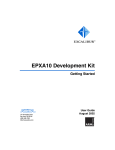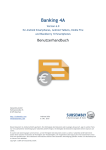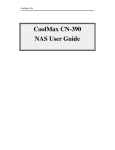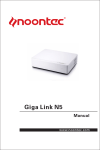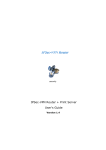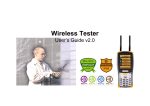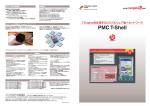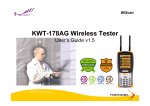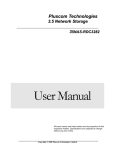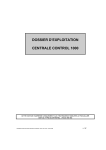Download NAS Dongle User Guide
Transcript
NAS Dongle User Guide INDEX Introduction ………………………………………………………... 6 Product specification ….………..………………………………….. 7 1. Install NAS Dongle ……………………………..……………… 8 1.1 Search NAS Dongle …………………....….………….….. 8 1.1.1 Search Disk Utility..……….………….…..……….…… 8 2. WEB Control Page …………………………..……..……..……. 9 2.1 Status ……………………………….……….…….……… 9 2.1.1 System Information …………………..….....…….……. 9 2.1.2 Network Information ……………….……..………….. 11 2.1.3 Service Information …………………..….…………… 12 2.1.4 Disk Information ………………………..……………. 12 2.2 IP Config. ……………………………….…..……..….…. 12 2.2.1 Auto IP …………………………………..……………. 12 2.2.2 Static IP ……………………………….….….……..…. 12 2.2.3 PPPoE ………………………………..…….……….… 13 2.3 Maintenance ………………………………….…….….… 14 2.3.1 Firmware Upload ………………………….…….…..… 14 2.3.2 System Reboot …………………….....…….…….….… 15 2.3.3 Factory Default …………………..……..….…….….… 15 2.4 SMB service ……………………….…….…….…….…... 15 2.4.1 Configure SMB Server …………………….………..... 16 -2- 2.4.2 Setting Up Windows XP Computers ………….…..….... 17 2.5 WebDAV service………………………………………….. 22 2.5.1 Setting up Windows XP Computer………………...…… 23 2.5.2 Mapping a Windows Drive to a WebDAV Server ……… 27 2.6 BitTorrent ………………………………………………… 30 2.6.1 Using Bit Torrent client …………………….…….……. 30 2.6.2 Mail Notification …………………………...…………. 31 2.7 Disk Utility …………………………………..…….…….. 32 2.8 Print server …………………….………………….……… 33 2.8.1 Configuration Printer Server of Windows .…….………. 33 2.8.2 Printer Server Configuration of Apple Mac OS X 10.2, 10.3, and 10.4 ……………………….…….. 38 2.8.3 Printer Configuration of Apple Mac OS X 10.5 ……..... 50 2.9 Media Server ………………………………………..……. 52 2.9.1 Share Media from NAS Dongle (Media server) with Xbox 360(Media player) …………………………....….. 52 2.9.2 Share Media from NAS Dongle (Media server) with PS3 (Media player) ……………………..…………….... 54 2.9.3 Share Media from NAS Dongle (Media server) with iTunes (Media player)……………..……..……………. 57 -3- Copyright This publication, including all photographs, illustrations and software, is protected under international copyright laws, with all rights reserved. Neither this manual, nor any of the material contained herein, may be reproduced without written consent of the author. Disclaimer The information in this document is subject to change without notice. The manufacturer makes no representations or warranties with respect to the contents hereof and specifically disclaims any implied warranties of merchantability or fitness for any particular purpose. The manufacturer reserves the right to revise this publication and to make changes from time to time in the content hereof without obligation of the manufacturer to notify any person of such revision or changes. Trademark recognition All product names used in this manual are the properties of their respective owners and are acknowledged. Federal Communications Commission (FCC) This equipment has been tested and found to comply with the limits for a Class B digital device, pursuant to Part 15 of the FCC Rules. These limits are designed to provide reasonable protection against harmful interference in a residential installation. This equipment generates, uses, and can radiate radio frequency energy and, if not installed and used in accordance with the instructions, may cause harmful interference to radio communications. However, there is no guarantee that interference will not occur in a particular installation. If this equipment does cause harmful interference to radio or television reception, which can be determined by turning the equipment off and on, the user is encouraged to try to correct the interference by one or more of the following measures: Reorient or relocate the receiving antenna. Increase the separation between the equipment and the receiver. Connect the equipment onto an outlet on a circuit different from that to which the receiver is connected. Consult the dealer or an experienced radio/TV technician for help. Shielded interconnect cables and a shielded AC power cable must be employed with this equipment to ensure compliance with the pertinent RF emission limits governing this device. Changes or modifications not expressly approved by the system’s -4- manufacturer could void the user’s authority to operate the equipment. CE MARK This device complies with the requirements of the EEC directive 89/336/EEC with regard to Electromagnetic compatibility” and 73/23/EEC “Low Voltage Directive”. About this manual This manual is intended for system administrators who are familiar with setting up a new system and installing an operating system. Safety information Before installing and using the NAS Dongle, take note of the following precautions: Read all instructions carefully. Do not place the unit on an unstable surface, cart, or stand. Do not block the slots and opening on the unit, which are provided for ventilation. Do not push objects in the ventilation slots as they may touch high voltage components and result in shock and damage to the components. Only use the power source indicated on the marking label. If you are not sure, contact your dealer or the Power Company. Do not place anything on the power cord. Place the power cord where it will not be in the way of foot traffic. Follow all warnings and cautions in this manual and on the unit case. When replacing parts, ensure that your service technician uses parts specified by the manufacturer. Avoid using the system near water, in direct sunlight, or near a heating device. This device complies with the requirements of the EEC directive 89 / 336 / EEC with regard to Electromagnetic compatibility” and 73/23/EEC “Low Voltage Directive”. -5- Introduction Thank you for purchasing the NAS Dongle. This product is specifically designed for Home and Personal needs, it is a convenient and economical solution for adding any USB storage devices onto your LAN. With it you will be able to access your shared files from any desktop or laptop within your network. Product Feature CPU:High-performance RISC CPU. Memory:32 MB DDR and 1 MB SPI Flash. Support 3.5” HDD max capacity up to 2TB. Web base interface, easy configuration, setting and management. Two USB 2.0 host interfaces enhance the convenience of USB peripheral links. * Mass NAS Dongle (Port A) is for read and write and the other (Port B) read only and print class. Gigabit Ethernet port delivers high speed data transmission. Support Samba server (maximum create 16 user account, 16 folder shared by one account) allowing data access from remote location. Samba 8 user, total 64 TCP connection at the same time Support BitTorrent server (maximum Peer 128) allowing data access from remote location Support Media server (XBOX 360 Client, PS3 Client, iTune, uPnP AV/Compliant DLNA V 1.5 and WMP12) easily to share Photo, music or Video files. Support Print Server. One touch backup button. Support XP, Vista, Windows7, Mac OS and Linux Operating system. -6- Product specifications Model Name HDH-00001 Controller chip CPU High-performance ARM922 compatible RISC Memory 32 MB DDR / 1 MB SPI Flash Interface LAN Standard 10/100/1000 Base-TX Auto MDI/MDI-X Connector RJ-45 Number 1 Speed Half-duplex and Full-duplex operation Throughput Aprox. Read: 20MB/s, Write: 12MB/s (+-10%) Maximum User Login Samba 8 User (Total 64 TCP connection at the same time) USB A 2.0 Mass NAS Dongle Read and Write USB B 2.0 Mass NAS Dongle Read Only and Print class Software Configuration Web base Network Auto IP(DHCP Server or DHCP Client)/Fixed IP/PPPoE/DDNS Samba Server User Level Access (maximum create 16 user account, 16 folder shared by one account) BT Download Tracker & DHT network (maximum Peer 128) Upload & Download Bandwidth control Media Server XBOX 360 Client (MP3, JPG, WMV)、PS3 Client (MP3, JPG, MPG [MPEG 1 or MPEG 2])、iTune (MP3)、uPnP AV/ Compliant DLNA V1.5、WMP12 Print Server LPR (RFC1179) Other UPnP, Bonjour System Tools Disk Utility, Firmware Upgrade, Reboot, Factory Defaults Support OS XP(SP3), Vista(SP2),Windows7 / MAC OS X (10.5.X) / Linux (Samba 3.X) HDD USB A File System Format Compliant FAT32 (maximum single file size 127GB)/ exfat USB B File System Format Compliant FAT32/ exfat Capacity range 2TB to 2GB -7- 1. Install NAS Dongle 1.1 Search NAS Dongle 1.1.1 Search Disk Utility Note: If your PC didn't install Java Runtime Environment, please download from http://www.java.com/ 1. Execute "Search Disk" Utility from PC Click “Connect” link to NAS Dongle Status page. Default user name and password "admin / admin" 2. Configure PC to be AUTO IP > If your network environment has DHCP server: NAS Dongle will get IP from DHCP server, in this condition, NAS Dongle role is DHCP client. > If your network environment has no DHCP server: NAS Dongle automatically become DHCP server itself, in this condition, NAS Dongle role is DHCP server, the default IP is 169.254.0.1 and your PC will connect NAS Dongle from browser. -8- 2. WEB Control Page 2.1 Status Display NAS Dongle current status 2.1.1 System Information 2.1.1.1 Host Name / Group Name Status -> click “Change” button at right side of Host and Group name field -> to get into Identification page > Host Name: default name is STORAGE-XXXX. The last 4 digits xxxx depends on NAS Dongle MAC address。 -9- NAS Dongle on a network needs unique name so they can identify and communicate with each other. It is recommended to keep host name short (fifteen characters or less) and easily recognizable. We recommend that you use only Internet-standard characters in the computer name. The standard characters are the numbers 0 through 9, uppercase and lowercase letters from A through Z, and the hyphen (-) character. Computer name cannot consist entirely of numbers, nor can they contain spaces. The name also cannot contain special characters, such as the following: <>;:"*+=\|?, > Group Name: default is “WORKGROUP” A group of computers which is connected in a network and share resources, such as printer and files, when you set up a network, Windows automatically creates a workgroup and assign it a name. 2.1.1.2 Administrator Status -> administrator field -> click “Change” button to get into administration page > Administrator field: default is “admin”, and this field can’t change by user > Password field: default is “admin”, this field will change login WEB password by user > Verify Password: confirm password After input password and click “ok” button, browser will re-login, and pop login dialog 2.1.1.3 Date/Time Status -> Date/Time field -> click “Change” button to get into Date and Time page > Click “Sync from PC” to synchronize with PC system time, than click “OK” button to leave Date and Time setting. Set up Date and Time manually: > Date: set manual Date (yyyy / mm / dd) - 10 - > Time: set manual Time (hh:mm:ss) > SNTP: enable/disable SNTP client > Time server: locate time server > Time Zone: click your current time zone in the list, and then click OK. > Daylight saving time: If your time zone observes daylight saving time and you want your NAS Dongle clock to be adjusted automatically when daylight saving time changes, make sure the Automatically adjust clock for Daylight Saving Time check box is selected 2.1.1.4 Firmware version Display firmware and loader version 2.1.2 Network Information 2.1.2.1 IP Address Display NAS Dongle IP address 2.1.2.2 MAC Address Display NAS Dongle MAC address 2.1.2.3 DHCP Server Enable / Disable DHCP server. > Enable DHCP server, NAS Dongle default IP is 169.254.0.1 > Disable DHCP server with no DHCP server environment, the NAS Dongle IP is 169.254.X.X, Disable DHCP server with DHCP server environment, the NAS Dongle get the IP from DHCP server 2.1.2.4 PPPoE Click the “Connect” to connect the internet - 11 - 2.1.3 Service Information SAMBA Service: Disable / Enable SAMBA server 2.1.4 Disk Information Display Hard Disk model / Free Size / Total Size information 2.2 IP Config. 2.2.1 Automatic IP Select “Automatic IP” to get IP address from DHCP server. 2.2.2 Static IP > IP address: this is the IP address assigned by your Router for NAS Dongle. You shall specify the IP address of the NAS Dongle here. e.g. 192.168.1.123 > Subnet Mask: an address code that determine the size of the network; this is the subnet mask of the NAS Dongle, when seen by external users on the Internet (including your ISP). The subnet mask is provided by ISP. e.g.255.255.255.0 > Gateway IP Address: an IP address forwards Internet traffic from your local area network (LAN). e.g. 192.168.1.1 > DNS Server IP address: you must specify DNS server IP address here if your ISP has the said address. - 12 - 2.2.3 PPPoE Some DSL-based ISPs use PPPoE (Point-to-Point Protocol over Ethernet) to let users establish Internet access. All local users can share one PPPoE connection to access the Internet. >Status: Display PPPoE connection status >Service Name: A PPPoE service name is either an ISP name or a class of service that is configured on the PPPoE server. - 13 - >Login User Name: Enter your user name provided by your ISP. >Login Password: Enter your password provided by your ISP >Service On Demand: The router will ONLY connect to your ISP on demand. By “on demand”, it means when any LAN user attempt to send data onto the Internet. When there is no data traffic, the router will close the connection to the ISP because there is no demand. >Idle Time (Seconds): Idle time means the NAS Dongle will disconnect after being idle for a preset amount of time. If you set the time to 0, the PPP session will not terminate itself. >Max Connection Time (Hours): >IP Address Negotiation: IP Address and Subnet Mask should be assigned within the same network as the PPPoE-enabled DSL modem. >Fixed IP Address: you can manually assign an IP address to the interface. 2.3 Maintenance 2.3.1 Firmware Upload You can select new firmware to upload. Please don't turn off the power and close the web browser when the firmware is uploading - 14 - 2.3.2 System Reboot Click the “Reboot” button to have the device perform a software restart. The SYSTEM LED will blink as the device restart and then remain on if the restart is successful. * Please wait about a minute before refreshing your browser before logging in again 2.3.3 Factory Default Click the "Reset" button to clear all configuration and reNAS Donglee to default settings. * Please don't turn off the power and close the web browser when the system is changing the settings. Please click "Reboot" button after reset. 2.4 SMB Server Samba is software that can be run on a platform other than Microsoft Windows, for example, UNIX, Linux, IBM System 390, OpenVMS, and other operating systems. Samba uses the TCP/IP protocol that is installed on the host server. When correctly configured, it allows that host to interact with a Microsoft Windows client or server as if it is a Windows file and print server. Share one or more directory trees Share one or more Distributed file system (Dfs) trees Assist clients with network browsing Provide or assist with Windows Internet Name Service (WINS) name-server resolution Share printers installed on the server among Windows clients on the network (not support) Authenticate clients logging onto a Windows domain (not support) - 15 - 2.4.1 Configure SMB Server Click SMB Server, the page show as below: NEW: create SMB share account (folder) and password , default account :guest,password: null Modify: - 16 - This page can modify as below, > Password: Password of SMB account > Access control: read only / read and write access control of SMB account > Folder sharing: Folder List are all existing folders in the NAS Dongle, Sharing List is share folder of SMB account. If you want to share some folders, select this folder from Folder List and add to Sharing List. > Folder manage: create / rename / delete folder Enable/ Disable: this button can enable/disable SMB account Delete: delete SMB account 2.4.2 Setting Up Windows XP Computers Although Windows XP is very similar to Windows 2000, but, it has a very different user interface and there are numbers of subtle differences. For example, getting to the Control Panel is different than in any previous version of Windows—one must click the Control Panel item from the Start menu (there is no Settings item in the Start menu in XP). By default, XP will display the Control Panel in Category View mode. If you see this, click the Switch to Classic View item in the upper-left corner of the window. All of our directions are for using the Control Panel in Classic View mode. You should perform the following steps as the Administrator or another user in the Administrators group. Networking Components Go to the Control Panel and double-click the Network and Dial-up Connections icon. You should see at least one Local Area Connection icon. If there is more than one, identify the one that corresponds to the network adapter that is connected to your Samba network. Right-click the Local Area Connection icon and click the Properties button. (Or double-click the Local Area Connection icon and then click the Properties button in the dialog box that comes up.) You should now be looking at the Local Area Connection Properties dialog box, as shown in below - 17 - You should see at least the following two components: • • Client for Microsoft Networks Internet Protocol (TCP/IP) If you do not see either Client for Microsoft Networks or Internet Protocol (TCP/IP) in your list, you will need to add them. For either, the method is to click the Install... button, click the type of component (Client or Protocol), and then click the Add... button. Next, click the component you want to add, and click the OK button. You should see the component added to the list with the others. Configuring TCP/IP Now click Internet Protocol (TCP/IP) and then click Properties to open the Internet Protocol (TCP/IP) Properties dialog box, shown in below - 18 - If you are using DHCP on your network to assign IP addresses dynamically, select the "Obtain IP address automatically" radio button. Otherwise, select the "Use the following address:" radio button, and fill in the computer's IP address and netmask in the spaces provided. You or your network manager should have selected an address for the client on the same subnet (LAN) as the Samba server. For example, if the server's address is 192.168.1.1 and its network mask is 255.255.255.0, you might use the address 192.168.1.12 (if it is available) along with the same netmask. You can also fill in the IP address of the default gateway. Computer and Workgroup Names From the Control Panel, double-click the System icon to open the System Properties dialog box. Click the Computer Name tab, and your System Properties dialog box will look similar to: - 19 - To give your system computer a name and a workgroup, click the Change... button, which will bring up the Computer Name Changes dialog box, as in below You need to identify your computer with a name and change the workgroup to the one you specified in the web page of your Samba server. Don't worry that Windows forces the workgroup to be all capital letters; it's smart enough to figure out what you mean when it connects to the network. - 20 - Connecting to the Samba Server Now your Samba server is running, and you have set up your Windows XP client to communicate with it. In the Start menu, select My Computer to open the My Computer window. Click My Network Places, in the Other Places box in the left part of the window. You should see a folder icon for the test directory, as shown in below Now click View workgroup computers in the Network Tasks box at the left of the window. You should see your Samba server listed as a member of the workgroup. Double-click its icon, and you will see a window that looks like If you don't see the server listed in the workgroup, select “Run” from the Start menu. A dialog box appears that allows you to type the name of your server and its share directory in Windows format. For example, you would enter \\toltec\test, as shown in below, and use your server's hostname instead of "Toltec". - 21 - If it works, try copy files to and from the server by dragging their icons to and from the Samba server's test folder. You might be pleasantly surprised how seamlessly everything works. 2.5 WebDAV Server - 22 - 2.5.1 Setting up Windows XP Computer 1. Click” My Computer” right button, select “Map Network Drive…” 2. Click “sign up for online storage or connect to a network server” - 23 - 3. Select” Choose another network location” 4. Please enter your NAS address and the network folder name which you want to access. Note: add /webdav/share/folder name (test) Windows XP example: http://192.168.1.39:80/webdav/public Windows 7 example: http://192.168.1.39/webdav/public 5. Please enter your User name and Password - 24 - 6. User can type a name for this WebDAV share folder 7. Set up completed. - 25 - 8. Now you can use the WebDAV function, Windows will create an icon in “My Network Places” - 26 - 2.5.2 Mapping a Windows Drive to a WebDAV Server This tutorial shows you how to connect a Folder or a Windows Drive Letter to any WebDAV server, what to do if the command fails, what not to do, and security. This tutorial is for Windows XP/Vista client users. The Two WebDAV Windows Clients Microsoft Windows provides two WebDAV clients: Web Folders and WebDAV Mini Redirector. The clients are integrated and come preinstalled with your Windows. Web Folders (XP, Vista) The first generation WebDAV client provided by Microsoft is called Web Folders and allows one to drag and drop between a remote WebDAV server and your local computer. The Web Folders client provides functionality similar to (secure) FTP. Note Web Folders is not available on Vista. How to connect: 1. Go to My Network Places, and click on Add Network Place at the top of 2. 3. 4. 5. 6. the left sidebar. The window that pops up is the Add Network Place Wizard. Click Next. On the next page, enter the URL of the WebDAV folder in the box named Internet or network address and click Next. A window asking for your username and password will pop up at this point. Enter your username and password, and click OK. On the next page, enter a name for this share -- this is the name that will show up in the My Network Places listing. Click Finish on the next page. WebDAV Mini Redirector ( Vista, and Win7) The second generation Microsoft WebDAV client is called WebDAV Mini Redirector and allows one to map a WebDAV location to a Drive letter the same way as if you were using a Windows File Sharing/SMB/CIFS share. - 27 - WebDAV Mini Redirector limitations: • No support for HTTPS, i.e. no support for secure connections. • Typically fails when transfering larger files. Gets confused if the user does not have access to read and/or write to a file or directory. • How to connect: 1. Right click on My Computer and select Map Network Drive. 2. In the Folder "entry field", enter the URL, and click Finish. 3. Enter your username and password in the authentication box that appears. You can use the network drive like you use your C:\ hard drive as soon as the command completes successfully. This means that you can directly work with documents without first copying them, start computer programs, and more over the Internet. The following image shows a Windows Explorer window listing the content of a WebDAV server. Direct Access Using Microsoft Office However, sometimes it can be quicker to open a Word document, Excel spreadsheet, or a PowerPoint presentation directly using Microsoft Office without having to first map a Windows drive. Many applications, including Microsoft Office, support WebDAV natively. This means you can use Microsoft Word to directly edit a document on your remote home/office computer. To open a remote Microsoft Word document, click File -> Open and simply type in the URL to your remote document. - 28 - Unfortunately, Windows' support for WebDAV is a little strange and may not always function correctly. We therefore recommend using one of the following WebDAV clients for Windows: • WebDrive is a robust product that has been on the market for many years. • DriveOnWeb is another good product, but the product is directed towards German speaking people. Total Commander together with the WebDAV plugin provides a FTP like interface to a WebDAV server. • How to fix Slow WebDAV Performance in Windows 7: 1. In Internet Explorer, open the Tools menu, then click Internet Options. 2. Select the Connections tab. 3. Click the LAN Settings button. Uncheck the "Automatically detect settings" box. - 29 - 2.6 BitTorrent 2.6.1 Using Bit Torrent client 1. User may find BitTorrent file from Internet and save the Torrent to local disk drive. 2 Click BitTorrent page 3. Browse and select torrent file from local disk drive to upload Download Queue 4. After few minutes, BT client will connect to the other BT client in internet and start to download data 5. When torrent downloading percentage show 100%, the data will store in download path. 6. You can access file from SMB client on the PC. 7. Information and configuration: System ID: torrent ID Number of the Downloads: number of torrent active Server Port: BT Server upload port Upload Limit: BT server upload throughput control 8. Mail Notification: when user stop or remove torrent, NAS Dongle will send the mail alarm to administrator email box. - 30 - >Enable: enable or disable mail alarm >SMTP Server: SMTP server address or IP (ex: ms48.url.com.tw) >Sender: email of sender (ex: sender@ ms48.url.com.tw) >Recipient: email of recipient (ex: recipient@ ms44.url.com.tw) >Mail Authentication: enable or disable Mail Authentication, if you need. >User Name: user name of Email account (SMTP/POP3 user name) >Password: password of Email account (SMTP/POP3 password) 9. Button of torrent queue >Path: open file manager by Samba (Network Neighborhood) >Restart: you can select a torrent to restart from download queue >Pause: pause you can select a torrent to pause from download queue >Show: show all BT information >Remove: you can select a torrent to pause from download queue 2.6.2 Mail Notification >Enable: enable /disable mail notification check box >SMTP server: SMTP server address Note: 1. Most SMTP server of ISP depends on IP which is assign from your ISP. Ex: If your SMTP server belong seednet “smtp.seednet.com.tw”, but you dial in “hinet”, - 31 - “smtp.seednet.com.tw” will reject transfer email. 2. NAS Dongle no support SSL SMTP server, like gmail >Sender: the address which send from. >Recipient: the address which send to. >Mail Authentication: enable /disable mail authentication check box >User name: mail authentication user name >Password: mail authentication password 2.7 Disk Utility Sleep Time: configure the time Hard Drive get into sleep mode - 32 - 2.8 Printer server 2.8.1 Configuration Printer Server of Windows 1. Connect USB printer to NAS Dongle USB B Port. 2. The Printer model will show up on Home page “Printer status” Note: The network printer or device will need a static IP address to be seen on your network by the computer. - 33 - 3. Click Start and select Printers and Faxes. 4. Under Printer Tasks, click Add a Printer. Click Next. 5. Select the Local Printer attached to this computer radio button. 6. Uncheck the automatically detect and install my Plug and Play printer check box. - 34 - 7. Click Next. 8. Select the Create New Port radio button. 9. From the Type of port: drop down list choose Standard TCP/IP Port. Click Next. Note: You will now be prompted for 2 items: the Name or address of server providing lpd and the Name of printer or print queue on that server. The 1st item is the Static IP address that has been assigned to the device. The 2nd item is the Queue Name that you found in the device's documentation. 10. In the Name or address of server providing lpd box, enter the IP Address of the device. - 35 - 11. Select “Settings” 12. Setup protocol LPR and queue name. - 36 - Note: If you receive an error message saying that the "LPD server did not respond as expected ...", click Cancel. Attempt to reenter the IP Address or Print Queue name. Click OK again. If this process fails, the device may not support LPR printing. You should stop now and contact the manufacturer for further assistance. 13. If Step 10 completed successfully, you are now ready to install the driver. Click Have Disk. Click Browse. 14. Locate and select the .INF file for the device. You may need to browse to the CD or to the folder on your computer where you have the device driver downloaded. 15. When ready, click Next. Note: If you are prompted to replace or keep existing driver, click on Keep Existing Driver. Click Next. 16. When asked to print a test page, click No. Click Next. Click Finish. Note: At this point, you should have the device listed in the Printers and Faxes - 37 - folder. You can attempt to use it as a printer. 2.8.2 Printer Server Configuration of Apple Mac OS X 10.2, 10.3, and 10.4 1. Open Macintosh HD on the Desktop, and click “Applications”. 2. Click “Utilities”. - 38 - 3. Click “Print Center”. In Mac OS X 10.4.x, it is named “Printer Setup Utility”. 4. Press “Add...”. - 39 - 5. It shows the dialog box of the printer configuration (Mac OS X 10.2.x/10.3.x). It shows the dialog box of the printer configuration (Mac OS X 10.4.x). - 40 - If you want to use AppleTalk and your printer is a PostScript printer If you want to use LPR or your printer isn't a PostScript printer AppleTalk 1. Mac OS X 10.2.x/10.3.x Select “AppleTalk” and “Local AppleTalk Zone”, the computer will find the print servers in the local area network. You can select the suitable printer model for your printer, or select “Generic”. Don't select “Auto Select”! Press “Add”. - 41 - Mac OS X 10.4.x Click “Default Browser”. The computer will find the print servers in the local area network. Select “AppleTalk”. You can select the suitable printer model for your printer, or select “Generic PostScript Printer”. Don't select “Auto Select”! Press “Add”. Bonjour, in Mac OS 10.2.x/10.3.x, is named Rendezvous. It is not a new protocol. It is just a solution while there isn't any DHCP server in your local area network and you don't know how to configure the fixed IP addresses to the print servers and the computers. Bonjour supports three protocols. LPR, IPP, and RawTCP. If you choose Bonjour, it will automatically choose one of the three protocols to print. And, you can use the non-PostScript printer driver. If your print server does not support Bonjour, don't choose this. - 42 - 2. We have already added a printer. - 43 - 3. Change Format for the printer you just added before printing, and then press “OK”. LPR 1. Download gimp-print-xxx.ppc.dmg and install this printer driver on your Apple Mac OS X.(ps: xxx is its version.) 2. Download espgs-xxx.ppc.dmg and install this printer driver on your Apple Mac OS X. (ps: xxx is its version.) 3. Download hpijs-foomatic-xxx.ppc.dmg and install this printer driver on your Apple Mac OS X. (ps: xxx is its version.) 4. Download gutenprint-xxx.dmg and install this printer driver on your Apple Mac OS X.(ps: xxx is its version. Gutenprint is the new name for Gimp-Print as of the 5.0 release.) 5. Mac OS X 10.2.x/10.3.x Select “IP Printing”. Mac OS X 10.4.x Click “IP Printer” and select “Line Printer Daemon-LPD”. - 44 - 6. Mac OS X 10.2.x/10.3.x Printer's Address: Input the IP address of your print server. (For example: 192.168.1.200) Disable “Use default queue on server”. Queue Name: lp1, lp2, or lp3 (fixed)If your print server is the 1-Port print server, its print port is the first.If your print server is not the 1-Port print server, for example, it is the 2 USB and 1parallel port print server, then, the parallel port is the first. USB 1 is the second. And, USB2 is the third.lp1 if your printer is connected with the first print port. lp2 if your printer is connected with the second print port. lp3 if your printer is connected with the third print port. Select the suitable printer model for your printer. If it is a PostScript printer but you don't know its model, please select “Generic”. - 45 - Mac OS X 10.4.x Printer's Address: Input the IP address of your print server.(For example: 192.168.1.200) Queue Name: lp1, lp2, or lp3 (fixed) If your print server is the 1-Port print server, its print port is the first. If your print server is not the 1-Port print server, for example, it is the 2 USB and 1parallel port print server, then, the parallel port is the first. USB 1 is the second. And, USB 2 is the third. lp1 if your printer is connected with the first print port. lp2 if your printer is connected with the second print port. lp3 if your printer is connected with the third print port. Select the suitable printer model for your printer. If it is a PostScript printer but you don't know its model, please select “Generic”. - 46 - - 47 - 7.Mac OS X 10.2.x/10.3.x If your printer is not a PostScript printer, please select the right manufacturer and model name. Don't choose “Generic”. And then press “Add”. Mac OS X 10.4.x If your printer is not a PostScript printer, please select the right manufacturer and model name. Don't choose “Generic”. And then press “Add”. - 48 - 8. We have already added a printer. - 49 - 9. Change Format for the printer you just added before printing, it will display the model of your printer. And then press “OK”. - 50 - 2.8.3 Printer Configuration of Apple Mac OS X 10.5 1. Click Apple Icon on the left-upper corner of Desktop, and click System Preferences.... Click Print & Fax. 2. Click Plus. - 51 - 3. Protocol: Line Printer Daemon – LPD Address: Input the IP address of the print server. Queue: lp1, lp2, or lp3 (fixed) If your print server is the 1-Port print server, its print port is the first. If your print server is not the 1-Port print server, for example, it is the 2 USB and 1 parallel port print server, then, the parallel port is the first. USB 1 is the second. And, USB2 is the third. lp1 if your printer is connected with the first print port. lp2 if your printer is connected with the second print port. lp3 if your printer is connected with the third print port. >Name: Input the printer name you prefer. >Location: Input its location. >Print Using: Select a driver to use... >Click Add. - 52 - 2.9 Media Server 1. Select Media Server sharing folder 2. Double click set button 3. Make sure media server (NAS Dongle) is same subnet with media player (X box 360 PS3 and iTunes) 4. Browse content from iTunes (music only), Xbox 360 and PS3 (music, photo, video) 2.9.1 Share Media from NAS Dongle (Media server) with Xbox 360(Media player) To access media files—including audio, video and pictures—from NAS Dongle, you need to connect an Ethernet cable from the Ethernet port on the back of your Xbox 360 console to your NAS Dongle. - 53 - 1. Connect your console to your NAS Dongle as described above. 2. Click Media Server page of NAS Dongle, and set up sharing list (photo, music, and video) 3. When setup is complete, Media Server of NAS Dongle should automatically start. 4. Xbox 360 will search for devices on your network. 5. On your Xbox 360 console, in the Media area of the Xbox Dashboard, select Music, Pictures, or Video. 6. Select NAS Dongle. 7. Find the media content that you want to play, and then select Play. - 54 - 2.9.2 Share Media from NAS Dongle (Media server) with PS3 (Media player) On your NAS Dongle: Click Media Server page of NAS Dongle, and set up sharing list (photo, music, and video). On your PS3: 1. Go into the PS3's Settings menu and navigate to Network Settings - Media Server Connection, and select Enabled. This allows the PS3 to detect networked device running Universal Plug and Play (UPnP) server software. - 55 - 2. When you turn on the PS3™ system, Media Servers on the same network are automatically detected and icons for the detected servers are displayed under (Photo), (Music), and (Video). 3. Select the icon of the DLNA Media Server that you want to connect to under (Photo), (Music), or (Video) in the home menu. All available folders and files that can be played by the PS3™ system will be displayed. 4. Select the file that you want to play. - 56 - Hints for PS3 • The PS3™ system must be connected to a network. For details on network settings, see (Settings) > (Network Settings) > [Internet Connection Settings] in this guide. • When the method of allocating IP addresses has been changed from Auto IP to DHCP under the settings for the network environment, perform another search for servers under • (Search for Media Servers). The DLNA Media Server icon is only displayed when [Media Server Connection] is enabled under • (Settings) > (Network Settings). The folder names that are displayed vary depending on the DLNA Media Server. • Depending on the DLNA Media Server, some files may not be playable or operations that can be performed during playback may be restricted. • You cannot play copyright-protected content. • File names for data that is stored on servers that are not compliant with DLNA may have an asterisk appended to the file name. In some cases, these files cannot be played on the PS3™ system. Also, even if the files can be played on the PS3™ system, it might not be possible to play the files on other devices. - 57 - 2.9.3 Share Media from NAS Dongle (Media server) with iTunes (Media player) 1. Make sure NAS Dongle media server enable (music) 2. select NAS Dongle on shared class 3. Find the music that you want to play. - 58 -


























































